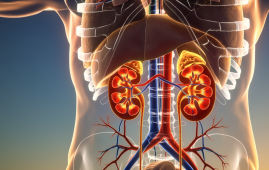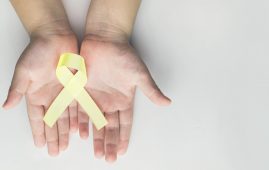

Researchers from the University of Pennsylvania’s Perelman School of Medicine and Children’s Hospital of Philadelphia (CHOP) discovered that cancer patients who continued to smoke after their diagnosis were significantly more likely to receive tobacco treatment when “nudges” to provide tobacco treatment were directed at clinicians via the electronic health record. The findings support the use of behavioral economics, or targeting predictable patterns in human decision-making to overcome barriers to behavior change, to improve outcomes for cancer patients.
The Journal of Clinical Oncology just published the findings online
More than half of patients who smoked before to being diagnosed with cancer continue to smoke after being diagnosed. This can reduce quality of life and hasten tumor progression. Routine, evidence-based tobacco use therapy (TUT) minimizes the risk of dying from cancer and other health conditions by often involving a referral to a smoking cessation clinic for counseling and potentially employing medication to help address tobacco use. Despite the benefits, only approximately half of cancer centers identify patient tobacco use, and even fewer directly engage patients in implementing a TUT strategy.
Researchers aimed to investigate the application of behavioral economics-informed strategies to boost TUT uptake among cancer patients and help doctors improve their desire to engage in TUT for their patients.
“Oncologists are faced with the challenge of responding to each patient’s individual cancer, so we wanted to see if we could develop a strategy for making their lives as easy as possible by providing simple, timely nudges to help patients engage in tobacco use treatment options,” said first author Brian Jenssen, MD, a researcher and primary care pediatrician with the Division of General Pediatrics at CHOP, a faculty member with PolicyLab and Clinical Futures at CHOP, a senior fellow at the Leonard Davis Institute of the University of Pennsylvania, and a member of the Abramson Cancer Center’s Tobacco and Environmental Carcinogenesis Program. “Clinicians can help their patients find ways of improving their health by helping them quit smoking in a nonjudgmental way.”
The researchers conducted a randomized clinical trial across 11 sites in the Penn Medicine Abramson Cancer Center (ACC) network in this investigation, which took place between June 2021 and July 2022. The study team created and delivered electronic health record-based “nudges” – brief messages intended to remind clinicians and their patients to incorporate tobacco treatment into their care plan – in four different combinations: patient only, clinician only, patient and clinician, and usual care with no nudges. These nudges were created to combat mental biases that work against TUT, such as concerns about the safety of tobacco treatments vs their potential advantages, as well as the potential diversion from medical therapy. In total, 246 ACC doctors were assigned to 95 clusters of 2,146 eligible cancer patients who smoked while getting cancer treatment.
When compared to normal treatment, the clinician nudge resulted in a considerable increase in TUT implementation (35.6% vs. 13.5%). Patient nudges had little influence on TUT adoption, implying that healthcare personnel are more effective targets for collaborating with their patients to embrace TUT strategies and that there is a continuing need to research ways to improve patient-facing tactics to increase TUT engagement.
“This study shows that a behavioral economics ‘nudge’ strategy can increase tobacco use treatment in the oncology setting, which we hope will help more patients with cancer control their tobacco dependence and enjoy better cancer care outcomes,” said senior author Frank T. Leone, MD, director of the Comprehensive Smoking Treatment Program at Penn Medicine, a professor of Pulmonary Medicine in the Perelman School of Medicine, and a member of the Tobacco and Environmental Carcinogenesis Program at the ACC. “We look forward to continuing to build on this research and further increase engagement with tobacco use treatment in the oncology setting.”
more recommended stories
 36-Week Pre-eclampsia Screening May Reduce Term Risk
36-Week Pre-eclampsia Screening May Reduce Term RiskA New Preventive Strategy for Term.
 Cardiovascular Risk and Sudden Cardiac Death in Diabetes
Cardiovascular Risk and Sudden Cardiac Death in DiabetesRising Sudden Cardiac Death (SCD) Risk.
 Poor Kidney Function and Alzheimer’s Biomarkers Explained
Poor Kidney Function and Alzheimer’s Biomarkers ExplainedPoor kidney function may influence levels.
 Walking Speed Before Hip Replacement Predicts Recovery
Walking Speed Before Hip Replacement Predicts RecoveryNew Evidence Points to a Simple,.
 Neuroblastoma Drug Combo Extends Survival in Models
Neuroblastoma Drug Combo Extends Survival in ModelsA Promising Shift in High-Risk Neuroblastoma.
 How Soybean Oil Impacts Weight Gain and Metabolism
How Soybean Oil Impacts Weight Gain and MetabolismWhy Soybean Oil May Affect Metabolism.
 Coffee and Cognitive Function: Evidence Review
Coffee and Cognitive Function: Evidence ReviewA new narrative review in Cureus.
 Colorectal Cancer Screening Rates Low in Adults 45–49
Colorectal Cancer Screening Rates Low in Adults 45–49Recent UCLA research reveals that colorectal.
 Gut Immune Cells and Long-Lasting Antiviral Protection.
Gut Immune Cells and Long-Lasting Antiviral Protection.Breakthrough Findings on How Gut Immune.
 Mild Pancreatic Duct Dilatation Signals Higher Cancer Risk
Mild Pancreatic Duct Dilatation Signals Higher Cancer RiskEarly Structural Changes Offer Critical Clues.

Leave a Comment